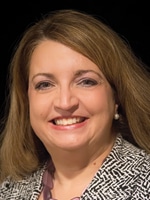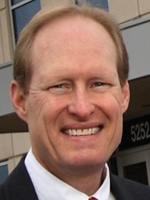March 2021—Tackling staff shortages, urging vaccination, answering questions about serology testing, and raising questions about variants were some of what Compass Group members were doing when they spoke on Feb. 2 about COVID-19.
“Staffing has continued to be a challenge, the greatest of which is phlebotomy staffing,” said Darlene Cloutier, MSM, MT(ASCP), HP, director of laboratory operations at Baystate Health, Springfield, Mass.
“Our biggest pain point is laboratory technologists,” said Tony Bull, executive director, AdventHealth, Orlando, Fla.
CAP TODAY publisher Bob McGonnagle led the roundtable. With him and Cloutier and Bull were Terrence Dolan, MD, Regional Medical Laboratory; James Crawford, MD, PhD, Northwell; Jennifer Laudadio, MD, University of Arkansas for Medical Sciences; Stan Schofield, MaineHealth; Sterling Bennett, MD, MS, Intermountain; Heather Dawson and Lauren Anthony, MD, Allina (post-roundtable, Dawson is with Philips Healthcare); Johan Otter, DPT, and Michael Quigley, MD, Scripps; Joseph Baker and Peter Dysert, MD, Baylor Scott & White; Linda Mirkes, MBA, MT(ASCP), Atrium; Judy Lyzak, MD, MBA, Alverno; and John Waugh, MS, MT(ASCP), Henry Ford.
The Compass Group is an organization of not-for-profit IDN system lab leaders who collaborate to identify and share best practices and strategies. Here is what they had to say last month.
Terry Dolan, can you fill us in on what’s going on at Regional Medical Laboratory?
Terrence Dolan, MD, president of Regional Medical Laboratory, Tulsa, Okla.: We’re seeing the positivity rate drop. It was running in the mid-20s—though we weren’t sampling the whole population—and now it’s in the mid-teens, and the antibody levels that were nonexistent in the spring are now running over 40 percent positive. We’re seeing fewer patients in the hospital in this area.
The variants haven’t hit here, although we’re not looking for them ourselves, and it is a concern. But we seem to be turning the corner, and all the health systems in this region are experiencing the same.
How is the supply chain?
Dr. Dolan (RML): Our volume of tests is down but still significant, and our supply chains are holding up well. We have multiple platforms—that was our strategy.

Cloutier
Darlene Cloutier, do you have equally good news to share with us from western Massachusetts?
Darlene Cloutier, MSM, MT(ASCP), HP, director of laboratory operations, Baystate Health, Springfield, Mass.: We are feeling the same cautiously optimistic relief. Our goal has been to sustain or increase our test volume capability and capacity, and gradually we’ve been able to do that.
Antibody testing is becoming a conversation among our providers—identifying COVID exposure versus vaccine response and what tests are good for each.
Staffing has continued to be a challenge, the greatest of which is phlebotomy staffing. We have sign-on bonuses in place, travelers in place. We’ve created different models of support for the team. We’re trying to launch a training program partnered with local phlebotomy certification programs to help us identify external candidates and create a pool of applicants to support this staffing. That’s been a big focus, particularly the inpatient side of phlebotomy.
Do you have retired phlebotomists who might be returning to help out?
Darlene Cloutier (Baystate): It’s possible. We see that in our technical staff—they retire and then we ask them if they want to come back as per diem, and many of them will.
Jim Crawford, tell us what’s going on at Northwell.
James Crawford, MD, PhD, professor and chair, Department of Pathology and Laboratory Medicine, and senior VP of laboratory services, Northwell Health, New York: Our testing continues to go up and up. We’re now receiving upward of 14,000 test samples per day. We load balance between doing it in-house and sending out to, in particular, one lab in Manhattan, and we keep that and other commercial labs on a short leash as regards turnaround time.
When turnaround time balloons at one of these labs, your sample is already there, and the real pinch point is the pre-procedure scheduled testing where patients show up the morning of and their PCR results are not back. So we are getting into an erratic routine of 5 AM phone calls where the PCR test is not back, and we have to re-swab and run the repeat test in the hospital on a cartridge before the patient can undergo the procedure. The root cause is that our clinicians are interpreting five days as three days as 48 hours, which turns out to be 30 hours. So there’s a lot of education of our medical staff as to how to pull this off. And the concept of, “Well, my patient is more important than other people; surely you can make it stat” currently exceeds our robust daily in-house capacity.
As regards workforce, we’re running about 130 percent of where we were prior to COVID, of which the last 30 to 35 percent is COVID testing, and yet we don’t have additional staff. So, yes, people are feeling tired. That’s one of our fundamental load-balancing activities—to make sure we take care of our staff.
The medical science of serology is interesting though not yet clear, but even if it’s not clear, our clinicians are still ordering about 2,800 to 3,000 antibody tests per day. I asked them, “What are you learning?” They say, “We’re seeing the footprints of disease.” Our serologic positivity rate has crept up from a steady 17 or 18 percent over the summer to mid-30 percent now.
The question of the hour, the question of today, which we are discussing at the state level, is viral sequencing. We at Northwell are stirring the pot because we need to be making decisions, not necessarily to test for medical practice, but about what we as a laboratory community should be doing to support public health.

Dr. Crawford
What is your own view on that? What will you tell your colleagues in the state?
Dr. Crawford (Northwell): We formed a New York State SARS-CoV-2 Testing Consortium, which consists of the laboratory leadership of 12 major academic medical centers in the state, and we have punched our way through any number of paper bags over the course of the last 11 months. The current paper bag is SARS-CoV-2 genome sequencing.
There are a variety of versions of the sequencing issue. The first is if it is just surveillance, samples are de-identified. But for tracer purposes, sequence information on identified patients has to go back to the source department of health, especially if the goal is to contain outbreaks of variants. There is ample evidence now that the U.K. variant B.1.1.7 is already present in New York State. So the real hobgoblin is what if one of the other variants that escapes monoclonal antibodies and vaccination enters our region? Will we identify it at the time of entry or are we going to be chasing it after it is already spreading? And all you have to do is look at the data from South Africa to have concern. The question I pushed in a state call is, what are the criteria for a successful regional strategy? Is it surveillance and tracer only? Is it sequencing in a clinically licensed lab where you can return the information for the purposes of patient care? Because if you were going to do monoclonal antibodies for a variant that may or may not be resistant, the turnaround time from a clinically licensed laboratory is critical.
Lastly, what is the relationship of sequencing, where you’re looking for any and all mutational variations, to multiplex PCR, where you have, basically, these are the ones we’re looking for, whether it’s in the S gene or somewhere else? Should you feed off sequence surveillance to do clinically licensed PCR testing, including looking for specific mutations, or S dropout on a multiplex PCR test? Should you have a more clinically oriented sweep of the population? At this moment in time, these are unanswered questions.
How much thinking and preparation can and should we do as a laboratory community with public health authorities to anticipate what could quickly be upon us? The CDC has contracted with LabCorp, Quest, and Illumina for expanded genome sequencing. Public departments of health around the country are being instructed to send samples to those three companies. The turnaround time supports surveillance but may not support tracer intervention. So the question I am asking at the state level is, how do we take care of our region, and what does that translate into?
Would you say the COVID situation as a matter of public health is improving in New York as you see it, or is it holding steady?
Dr. Crawford (Northwell): The lid is still on the pressure cooker; the second surge is plateauing. The positivity rates are dropping a bit, as are hospitalization rates. As long as a new variant of concern doesn’t enter the area, there is cautious optimism that we may be able to see things through.
Jennifer Laudadio, your state is not nearly as big or complex as New York, but tell us what’s happening in Arkansas at UAMS.
Jennifer Laudadio, MD, professor and chair, Department of Pathology, University of Arkansas for Medical Sciences College of Medicine: Last week we were feeling hopeful as our inpatient numbers started to decline, and then over the weekend they went back up and we now have as many inpatients. We’re at our highest level, exceeding where we were right after the holidays. So we continue to struggle with that and the nursing shortages that go with it. On the laboratory side, we are adequately staffed other than at quarantine times.
We have achieved vaccination of about 75 percent of our laboratory. The remaining individuals are either waiting because they are being asked to wait 90 days from testing positive or they are just going to decline, but we’re at a pretty good number for the lab overall.
What’s the demand for antibody testing?
Dr. Laudadio (UAMS): Almost zero. We announced to the health system that we have it, and we’ve gotten inquiries about what the utility is. We tell them we don’t know that there is any, and so people aren’t using it outside of the convalescent plasma setting.
Stan Schofield, have you had an easy time getting vaccinations to laboratory staff who need it?
Stan Schofield, president, NorDx, and senior VP, MaineHealth: We were in the first group to be vaccinated, and about 68 percent of the staff have been vaccinated. Every day I send out a message to the staff and the managers to get vaccinated: It’s important for your health, your safety, your coworkers, your patients. We have groups that are reluctant. They’ve been working from home; they’re not considered high risk in what they’re doing now. They’ve been a little slow to take up the vaccination.
I fully believe the variants are here and I’ve been instructing my staff to gear up for another surge in late March, early April, to stockpile reagents and pipette tips. Part of the message is if the variants are here, you want to be vaccinated.
Jim is right about sequencing. The government has been slow. They’ve tried to figure out what it means. It’s expensive. Now we’re being instructed to start sending positive samples to the CDC, or asked what the sampling methodology is, what the demographics are, what’s going on. It’s a poorly organized situation for the variant by the federal government, and the states are clueless. To me that means what we’re doing is Groundhog Day from a year ago: Nobody knows what they’re doing, nobody knows who’s in charge, and at the end of the day we’re going to get the same results and it’s not going to be pretty. Based on my Groundhog theoreticals, I think in late March we’re going to have the U.K. B.1.1.7 surge at the least. South Africa is still a wild card, and that’s the one I would be most worried about, but it’s been pretty contained there.
I don’t know that the vaccination rollout has been adequate to defer or deflect that.
What is your experience with demand for antibody tests so far at NorDx?
Stan Schofield (MaineHealth): Slim to none. We’re still testing 4,000 patients a day on PCR and we’re getting five to six, maybe 10, antibody test requests a day. We think antibody testing in the spring on a quantified antibody will probably be in demand after the vaccines are out, as part of the immunological status of patients going forward, and we’re prepared. But at the moment it’s a non-event.
Tony Bull, tell us about the COVID life in Orlando.
Tony Bull, executive director, AdventHealth, Orlando, Fla.: Our biggest pain point is laboratory technologists, and that’s been a limiting factor in COVID testing. We are bringing in a group of people from overseas to help us.
We’re not doing much antibody testing yet. We’re still waiting for that to be discovered. Florida is seeing the U.K. variant more than anywhere else, but we are seeing an easing in our positivity and hospitali-
zations.
For rapid testing, we’re limited by what we can get, like everyone else. Our pain point now, too, is media. We started doing all our own testing, so we no longer had send-out labs to provide us with media. We make our own and we’ve outstripped our capacity.
What is the vaccination rate for laboratory staff?
Tony Bull (AdventHealth): All lab employees have had the opportunity and we’re around 80 percent vaccinated.

Dr. Bennett
Sterling Bennett, please tell us about Salt Lake City.
Sterling Bennett, MD, MS, medical director, Intermountain Healthcare central laboratory, Salt Lake City: We saw a surge in cases after Christmas, but since that time our number of tests and number of positives have dropped to October levels. Our positivity rate on a seven-day moving average is now under 15 percent; it was pushing 30 percent at the first of the year. We know the U.K. variant is in Utah. Our state lab is doing sequencing on a limited number of samples. We provided a sample from a case in December that turned out to be the U.K. variant. There are now three documented cases in the state. Whether it’s lurking out there and going to come roaring up soon is unknown. Wouldn’t surprise us.
Do you share Stan’s prediction that we’re going to see a resurgence due to the variant taking root?
Dr. Bennett (Intermountain): There’s a high likelihood of that.
 CAP TODAY Pathology/Laboratory Medicine/Laboratory Management
CAP TODAY Pathology/Laboratory Medicine/Laboratory Management
